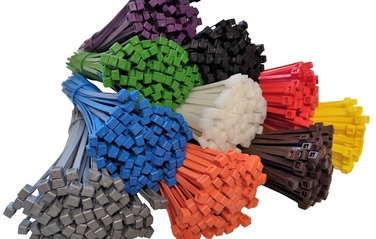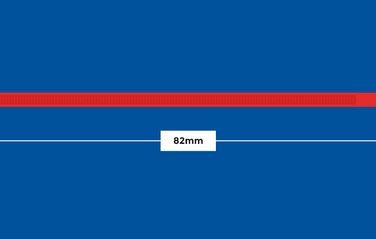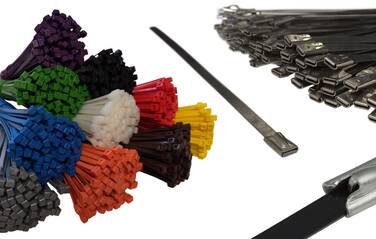What are nylon cables ties? What are they made from and what can I use nylon cable ties for? And exactly how strong are they? We have the answers to all your questions in this helpful guide.
What are nylon cable ties?
A nylon cable tie is a long thin strip of nylon that is used to hold items, usually cables, together in bundles. Cable ties were originally invented by Maurus C Logan after a visit to an aircraft facility in the 1950s. He witnessed the devastating effects that securing the aircraft cabling and wiring had on workers’ hands, and decided to create something to make their lives easier. It took him 2 years to finalise the design, which was patented in 1958. Cable ties are also known as zip ties, hose ties or Ty-Rap (a brand name).
How do nylon cable ties work?
One end of a cable tie is pointed and features serrations or ridges (a gear rack). The opposite end of the tie has a ratchet within a square hole. When the pointed end is passed through the square head and past the ratchet, it cannot be pulled back, resulting in a loop which can be tightened and which self-locks.
What are nylon cable ties made from?
Nylon cable ties are made from a group of plastics known as polyamides and are usually either nylon 6 or nylon 6/6. These figures refer to the chemical structure of the particular nylon used and while each type shares some qualities, we supply only nylon 6/6 cable ties. To learn more about the science behind the types of nylon used in the manufacture of cable ties, read our blog What are cable ties made of?
What are nylon cable ties used for?
Still predominantly used to bundle wiring and cables together, cable ties today play a part in industrial, commercial and domestic applications. In the aircraft and automotive industries, cable ties enable efficient cable management and the range of sizes available allows them to be used for everything from large, heavy hoses to delicate wiring in confined spaces. Their chemical and heat resistant properties also makes them ideal in environments where oil and petrol are to be found. In food production and the pharmaceutical and healthcare industry, variations of the standard nylon 6/6 cable tie are used. Closer to home, cable ties are indispensable for keeping unruly and unsightly cables at bay in the home office or behind the entertainment station. However, they can also be used in the garden and elsewhere around the house and some people have been known to create works of art out of them!
How strong are nylon cable ties?
Cable tie strength is known as tensile strength and is generally measured and given in kilograms. For example, our 80mm x 2.5mm nylon 6/6 cable tie has a tensile strength of 8kg which refers to the maximum load this cable tie can bear before breaking. Our widest nylon 6/6 cable tie (12.7mm) has a tensile strength of 114kg. Our blog, How strong are cable ties? discusses the tensile strength of all our cable ties.
Features of nylon cable ties
Nylon 6/6 cable ties are strong and flexible and offer a high resistance to heat and chemicals. With a working temperature range of minus 40°C to 85°C (minus 40°F to 185°F), nylon 6/6 meets all UL94V-2 flammability ratings. Nylon 6/6 can also be heat stabilised without compromising its physical properties when exposed to temperatures up to 125°C, and it can also be UV stabilised making it ideal for prolonged outdoor exposure.
What are the different types of nylon cable tie?
In addition to our standard nylon 6/6 cable ties, we offer printed nylon cable ties, releasable cable ties, marker cable ties, metal detectable nylon cable ties, and UV & heat stabilised cable ties. So, whatever the job you are tackling, we are sure to have a cable tie to meet your needs.
For any further information about any of our cable ties, our knowledgeable staff can be contacted with any questions on 01623 706241 or by email at sales@cableties-online.co.uk








